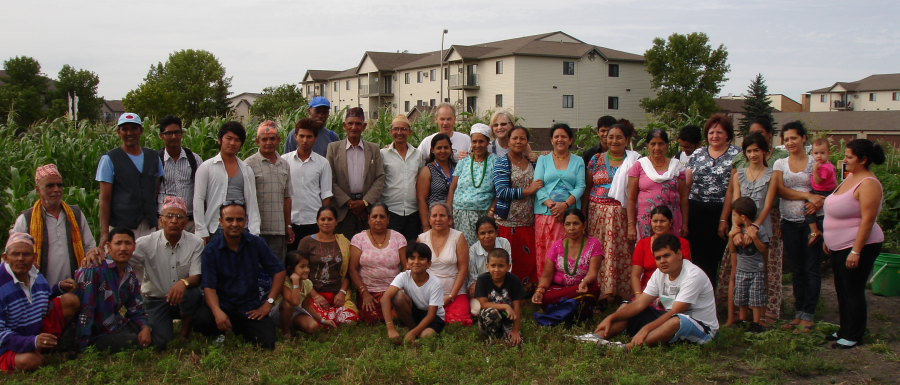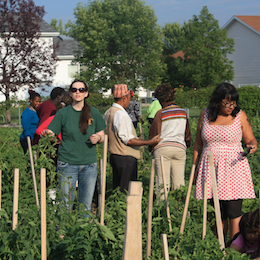Growing Together
A community garden that welcomes newcomers and provides access to nutritional foodParticipants
- New Americans from many different countries together with their neighbors in Fargo
- Support from many local groups including Charism Neighborhood Center, local Scouting and 4H groups, church congregations, Rotary, Chamber of Commerce
Desired Outcomes
Growing Together seeks to create safe, welcoming spaces for New Americans to build relationships in Fargo. They also want to increase New Americans’ access to nutritious food.
How Growing Together Builds Relationships
Organizers sought feedback on their idea from New Americans before initiating the program, and what they grow is partially based on the preferences of the participants.
Costs
- Initial donation of tools
- Requires $1500/year to run six gardens (seeds, tools, other gardening supplies)
Time Resources
Organizers meet once a month during the offseason to plan. During the growing season, gardening takes place every day except Sunday at one or more of the gardens.
Other Resources
Cooperating landowners provide water, land, and liability insurance, which greatly lowers the cost of the program.
Direct Partners
- Fargo Parks Department
- Lutheran Social Services
- Bell State Bank

Our Story: "We needed to make it feel like a community, not a charity."
We needed to make it feel like a community, not a charity.
The program does not have 501(c)(3) status, and, while they have received some small grants and donations, they do not pursue large grants. They save their own seeds, rather than buying seeds. One of the organizers, Jack Woods, starts many seeds in his basement before planting time; the group has also been able to start seeds in a greenhouse at North Dakota State University. Initially, they received some money from Bell State Bank that allowed them to buy tools for the gardens. Since the collaborators who own the land pay for water, liability insurance, the group need not seek much outside funding for operations. Two of the gardens are on Fargo Parks Department land, two are on Lutheran Social Services land, one is on a medical center’s land, and one is on a local church’s land.
Benefits
For New Americans who come from agrarian societies, gardening offers a comfortable, familiar activity. Many Growing Together participants form trusting relationships with other participants as they garden with each other, even though many start off suspicious of others. Organizers report that this program has helped to increase trust surrounding food for many participating New Americans, helping them overcome fears about accessing food, grounded in past food insecurity and experiences in refugee camps. Finally, by growing food in the gardens, some participants save up money for large purchases such as cars or freezers, and/or find they do not need to spend all of their SNAP (Supplemental Nutrition Assistance Program) benefits.
Things to Remember
- Gain easy and reliable access to a water source.
- Create a consistent schedule of when you will garden so people know what to expect.
- Maintain clear organization and clear communication system.
Challenges
Organizers have struggled to devise an effective method for distributing harvested vegetables. They used to separate the vegetables into boxes and then pass those out, but not everyone wanted all of the vegetable varieties. They currently use a system where everyone lines up to choose by category, but worry that distributing in this way may be stressful for some participants, as it resembles experiences in refugee camps. Some people may worry about the food running out before their turn comes. Organizers have been trying to come up with a new system for food distribution. The timing of Ramadan also poses a challenge because it reduces participation among Muslim New Americans when it falls in the middle of the growing season. Due to their cooking responsibilities, Muslim women’s participation in particular falls off during the month of Ramadan.
